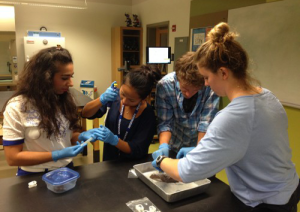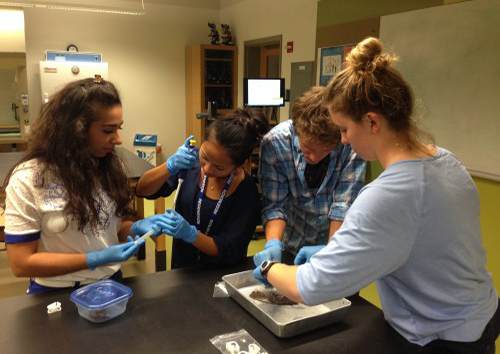
Left to right: GWU students Shayda Shabazi and Jun Xi Ni, Thomas Burchfield (COL ’15) and Maryellen Campbell (COL ’16)
Maryellen Campbell (COL ’16) and Thomas Burchfield (COL ’15) worked for months on an experiment that would test whether chrysanthemums could remove harmful toxins from the air in space shuttles, only to watch the rocket that carried the experiment explode seconds after launching.
The project, which Campbell and Burchfield worked on alongside George Washington University seniors Jun Xi Ni and Shayda Shabazi, was set to go into space in the Orbital Science Antares rocket, a medium-class vehicle with a launch reliability rate of 95 percent, but the unmanned rocket exploded just seconds after it was launched in Virginia on Oct. 28 due to a failure in one of its main two engines. The rocket’s primary purpose was to deliver supplies to the International Space Station, but it did carry several scientific experiments as well, including that of the students.
The four students developed the project through the D.C. Space Grant Consortium’s K-12 STEM Educator Program and won a competition against 31 other students, allowing their experiment to be sent to the International Space Station to be conducted by astronauts according to the students’ instructions.
The students were interested in seeing whether chrysanthemums could be used to detoxify the air on space shuttles, which expose astronauts to high levels of radiation, by observing germination and reproduction patterns.
Despite this setback with the Orbital Sciences Antares rocket, the team will use leftover materials and their research to replicate the experiment to be launched in the SpaceX Shuttle at Cape Canaveral Air Force Station on Dec. 9.
Campbell and Burchfield watched the initial rocket launch from about a mile and a half away.
“I was shocked watching it explode in front of me. I have never seen anything like it,” Campbell said.
Campbell said she did not expect to see an explosion, although a presenter in a briefing the day before explained that the shuttle would be detonated if there were immediate and significant malfunctions in the shuttle after launch.
“Firstly, I was relieved to know there were no injured and I wasn’t too upset about our experiment because it is easy to replicate,” Campbell said. “I believe there was about $200 million dollars worth of research and supplies lost, and that is devastating for the scientific community.”
Georgetown biology professor Sarah Miller, the team’s faculty adviser, said that while she was shocked about the explosion of Antares shuttle, her professional training as a biologist taught her to expect and work around failure in experiments.
“I was of course quite surprised when I found out about the rocket explosion. I felt upset for the students, but at the same time, I know all too well that experimental failures of one kind or another are an incredibly common and, often, incredibly important part of the scientific process,” Miller said. “In the grand scheme of reasons for experimental failures, this is probably among the most spectacular that I’ve experienced.”
Miller said that she is proud of the student team for quickly mobilizing to recreate their project.
“I think that the students handled this setback with great maturity and optimism,” Miller said. “They, too, realized that it would be feasible for them to set up the experiment again and that the scientific process does not always proceed as expected.”
Campbell said that because there is limited space on shuttles to the ISS, her team was responsible for meeting all of the same deadlines and following the same procedures as scientists competing to send their experiments to the ISS through NASA.
“I was excited by the authenticity of the program,” Campbell said. “How many people, let alone someone my age, can say they sent an experiment to the International Space Station? These are experiences I will never forget.”
Ni was unable to go to the launch and found out about the explosion from a friend. She said she was excited that the experiment will still go to the ISS and that she appreciated the experience she gained from working on it.
“It was exciting because I wasn’t aware of the process that scientists and researchers go through to get one of their experiments approved,” Ni said. “I realized how competitive it is and taught me how to work in a group and brainstorm with little guidance.”
Shahbazi said that, despite the explosion, she learned a lot from the process and was excited to move forward with the project.
“This project allowed me to follow an idea from conception to launch, literally,” Shahbazi said. “Seeing the changes an experiment undergoes has made me appreciate research to a greater extent. I’ve learned how necessary it is to be patient when working in research, especially with a setback like the one that occurred with the rocket explosion.”





















